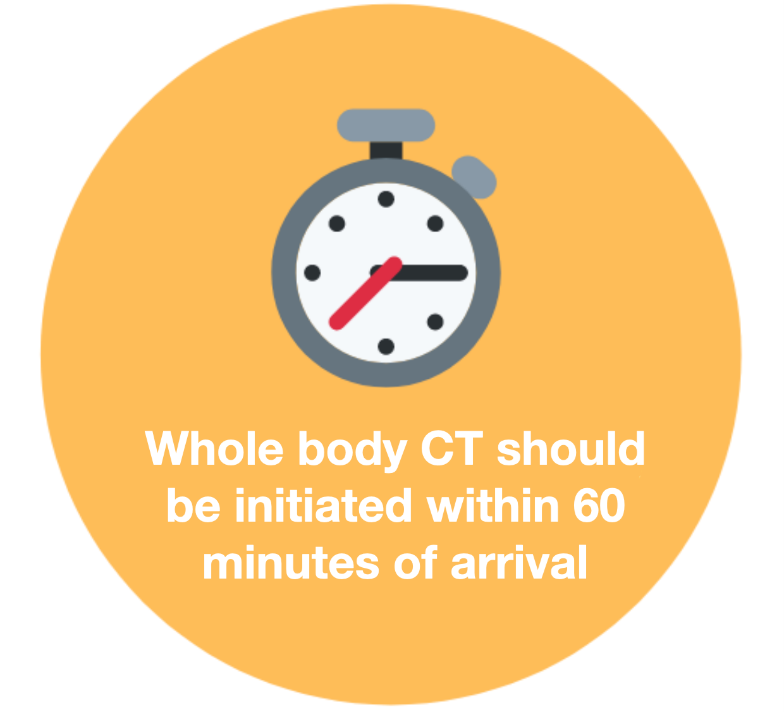- The Trauma Team Leader is in overall charge in acute care. If a patient moves directly from the ED to theatre, the TTL will receive updates on scan findings and relay these to theatre teams as appropriate. The acute trauma setting is not the place for disagreements about the patient pathway. Individual cases and pathways should be reviewed regularly at departmental/multidisciplinary meetings.
- CT Imaging for the major trauma patient should be performed as per established and agreed protocols in the department.
- CT requests must comply with Ionising Radiation (Medical Exposure) Regulations.

Principles
Time to CT
- Plain films and FAST scans should not delay time to CT.
- Major Trauma patients should have their CT started within 1 hour.
- There should be an awareness of pregnancy status in females of childbearing age.
Trauma CT protocol
- A split bolus protocol is the standard for Trauma CT scans in stable patients.
- For unstable patients, separate arterial and venous phase images are obtained. This is to aid IR in finding bleeding points to embolise.
- Vertex to mid-thigh scanogram followed by CT from vertex to pelvis.
- Clinical findings and the scanogram may direct CT to include the limbs.
- Do not reposition the patient.
Indications for trauma CT
Please also refer to the Guidance on Requesting Whole Body CT in Trauma, below.
- The mechanism of injury or presentation suggests that there may be occult severe injuries that cannot be excluded by clinical examination or plain films
- FAST has demonstrated free fluid.
- Plain films suggest significant injury e.g., pneumothorax or pelvic fracture.
- There is obvious severe injury on clinical assessment.
- Post –operatively in severely injured patients who were taken straight to theatre.

Reporting of trauma CT
- MTC only - A written primary survey report should be issued as soon as possible to TTL. This report should be scanned into RIS (Radiology Information System) prior to handing over to TTL.
- For remote centres, a verbal report should be given in place of the written preliminary survey report.
Guidance on requesting whole body CT in trauma
Whole body CT is indicated (or should be considered) when at least one criteria from 2 of the following categories have been met:
Category one - mechanism
RTA
- Fatality in the same vehicle
- Ejection from vehicle
- Entrapment / Prolonged extrication
- Pedestrian / Cyclist / Motorcyclist vs Vehicle.
Fall
- > 2m/One flight of stairs.
Category two - injury
- Visible injury to more than one body region
- Chest injury with altered physiology
- Suspected pelvic fracture with hypotension
- Spinal trauma with abnormal neurology
- Significant abdominal injury e.g. External evidence / guarding severe pain.
Category three - physiology
- Systolic BP <90mmHg (or 100mmHg if >55 years old)
- RR <8 or >30
- GCS <13
- Age >65
- Anticoagulated
